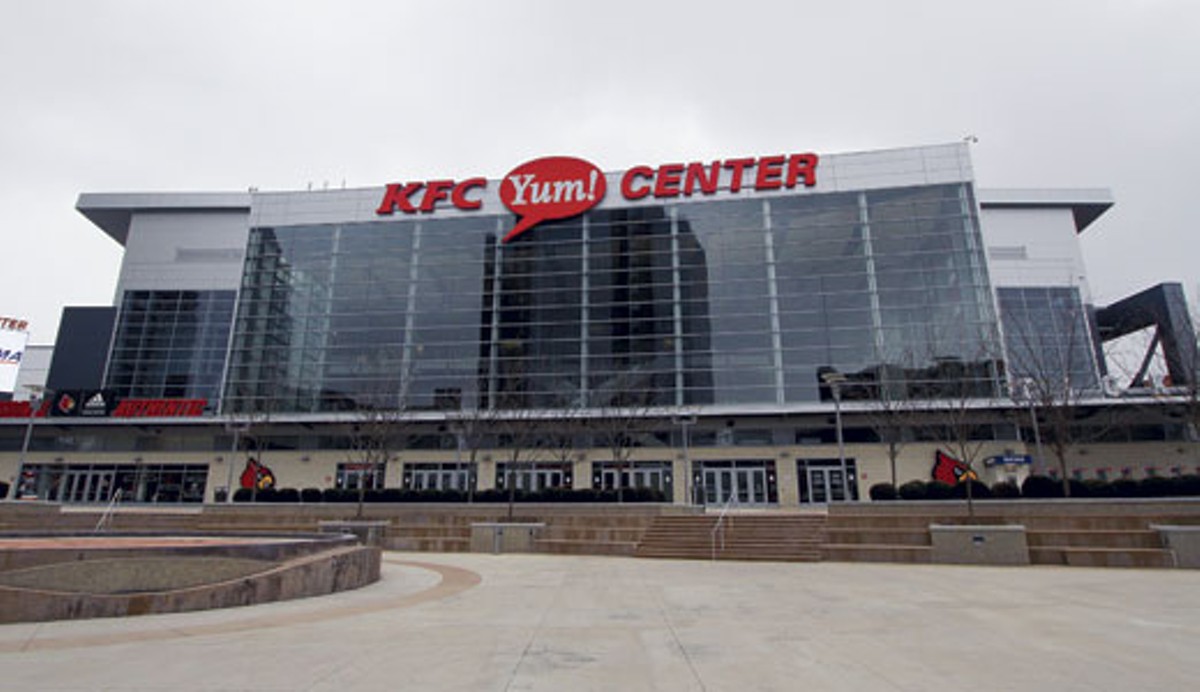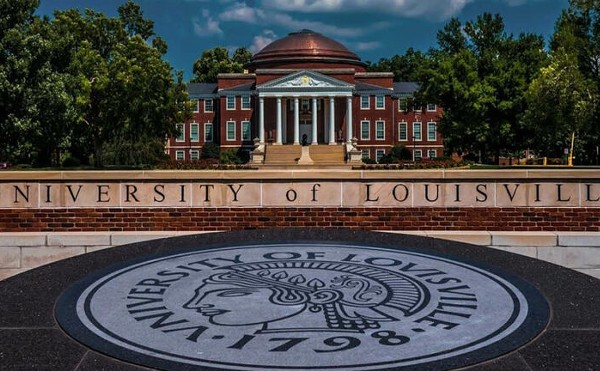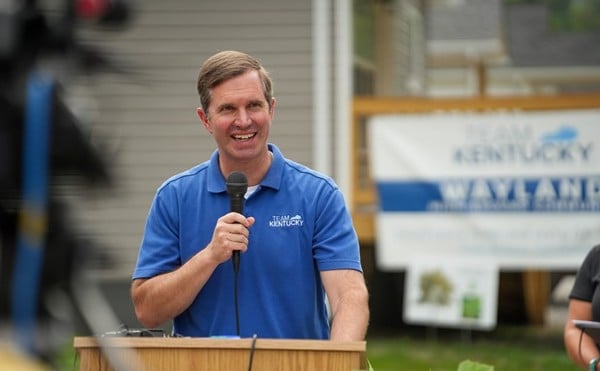Shortly after the University of Louisville Cardinals completed their inaugural basketball season in the immaculate new KFC Yum! Center in 2011, financial behemoth Goldman Sachs released a series of ads touting their role in pushing the arena’s financing across the finish line.
“How do you put together a package and a financing plan that investors will have faith in and ultimately buy and believe in the future of growth in downtown Louisville and the ability of this arena to generate revenue?” Tom Rousakis of Goldman Sachs asked in the slick, black-and-white ad, which portrayed the investment-banking firm as altruistic savior of this city’s downtown economy.
“Basketball is religion in Kentucky. It’s the one thing everybody rallies around,” declared the star of the ad, Jim Host — original chairman of the Louisville Arena Authority, recent inductee into the NCAA Hall of Fame, and the key player in pulling off the arena financing deal back in 2008. When it came to city and state leaders agreeing to pony up taxpayer dollars to pay back construction bonds on the arena, Host was another force of nature everyone rallied around, and his strategy to finance the arena was taken as the Word of God.
With Goldman Sachs as lead underwriter for the $359 million in arena construction bonds, Host devised a seemingly painless way to repay the bulk of the debt over the next 30 years: a 6-square-mile “tax increment financing” district. A TIF district is a set area surrounding a major development — in this case the arena — in which future gains in property tax and sales tax revenues are used to repay the debt incurred from the project.
Following the final sale of bonds, Host bragged that this was such a sure bet that the debt would probably be paid off early.
Today, however, such optimism appears at best naïve, at worse reckless.
The economy that was nose-diving during the summer of 2008 when Host and Goldman Sachs finalized the bond deal would soon crater into the Great Recession, along with any realistic chance that the arena’s inordinately large TIF district could create the projected revenue required to make future debt payments.
In its first three fiscal years — 2010 through 2012 — TIF revenues brought in only 32 percent of what was originally projected, almost $14 million short, the result of sluggish sales taxes.
Matters were further complicated by lower-than-expected arena profits, as the now-former operator Kentucky State Fair Board couldn’t control expenses, leading Host and Gov. Steve Beshear to spearhead the ouster of the agency’s longtime CEO Harold Workman last year. Ultimately, entertainment company AEG was hired to take over the arena.
In order to make up for these shortfalls, the Arena Authority has cleared out its $3 million maintenance fund, considered selling off $5 million of profitable securities it owns, and notified Metro Government it should be prepared to kick in an additional $1.3-$2.3 million this year — on top of the city’s annual $6.5 million minimum payment — to avoid the threat of default.
However, none of these measures prevented the bond rating agencies Moody’s and Standard & Poors from giving the Arena Authority the kiss of death last year by downgrading their ability to pay back their debt.
As bad as this looks, the wheels haven’t come off completely. The Arena Authority hasn’t missed a debt payment and still has $15 million in reserve funds, and AEG is projecting a $1.3 million profit this year due to its success at bringing in more big-name concerts and reigning in operating costs.
Additionally, the U of L Athletic Association has dramatically increased revenues via the arena, with its men’s basketball program bringing in more money than any in the country. That, however, only benefits university athletics.
But the dark cloud of the underperforming TIF district still looms, as original estimates predicted TIF revenues would double by 2018, with debt payments nearly doubling by 2028.
State and local government officials may soon find themselves veering closer to the same fate faced by elected leaders in other cities around the country, where projected revenue isn’t materializing for similar high-risk gambles on publicly financed sports arenas and stadiums, forcing taxpayers to keep them afloat.
Last year, the arena’s TIF district produced $3.5 million in revenue. By 2018, the Arena Authority predicted that number would be $20.6 million, which would in turn be used to pay a large majority of its $25.1 million debt payment that year.
Though growth in the TIF district picked up in 2012, the type of growth required to increase this revenue nearly 600 percent over the span of five years appears virtually impossible.
While shortfalls in future years could mean Metro Government consistently pays an additional $3.3 million annually — adding a hefty strain to a budget already struggling to provide needed services — there’s also the even greater fear that these funds and operations revenue (a guaranteed minimum of $1 million from AEG) still wouldn’t be enough to meet debt service payments.
Though the Arena Authority has $15 million in reserve funds, a few lean years in a row or another downturn in the economy later this decade could potentially drain this fund, risking more bond downgrades or forcing city and state leaders to face the worst of dilemmas: an arena default, or an additional taxpayer bailout from general funds.
But Arena Authority Chairman Larry Hayes says no crisis exists with their ability to meet debt payments, saying the TIF revenue should have no problem reaching its 2018 projections with a modest growth rate.
“It certainly works if you take 5 percent a year growth rate, even a little less than that,” says Hayes.
Metro Council President Jim King, D-10, who serves as a nonvoting member on the Arena Authority’s Board of Directors, has consistently dismissed concerns about the authority’s finances over the past few years, insisting it will work itself out once the economy is back to normal.
However, King now tells LEO it is “legitimate to wonder if the TIF district is going to achieve its projected results,” and while he is optimistic the TIF will grow at historic levels as the economy expands, the numbers in the years ahead look daunting.
“It’s a mathematical question,” King says. “But I wouldn’t think that 7 percent compound-growth would allow $3.5 million to grow to $20 million in 5 years, if that’s what you’re saying.”
Councilman Kelly Downard, R-16, who also serves on the Arena Authority board, stresses that while TIF performance is a concern, last year’s growth is a good sign, and it is too soon to panic.
“I don’t think we ought to ring the death knell,” Downard says. “It’s not a crisis, but it is a time of great concern and attention.”
As for the looming increase in projected TIF revenue by 2018, Downard concedes, “That is a huge number. And very frankly, if we don’t do something to increase the amount of growth in our urban core, then we’re going to have a problem.”
King and Downard, as well as Mayor Greg Fischer, express optimism that new growth downtown will turn TIF revenues around, pointing to the future completion of Whiskey Row and new commercial developments on South Fourth Street.
While more business and development near the arena certainly can’t hurt, another glaring weakness of the TIF district is the lack of enough dates at the Yum! Center to drive more people downtown to spend money.
One solution to this problem is an old idea that has failed to come to fruition for many years: luring an NBA franchise to Louisville, adding at least 41 more dates to the arena’s calendar.
J. Bruce Miller, a longtime crusader of bringing pro basketball to the city, has jumpstarted his PR campaign into full gear over the past few months, and Mayor Fischer has publicly supported the idea of competing for an NBA franchise.
However, such an option doesn’t appear realistic in the near future, especially given opposition from the arena’s anchor tenant, the University of Louisville Athletic Association.
U of L is resistant to sharing its space and available dates for games and practices, as well as altering an extremely favorable lease that has seen the athletic department’s revenue skyrocket since moving into the Yum! Center from Freedom Hall.
Even before the move, U of L Athletics was already one of the most profitable departments in all of college sports, but the Yum! Center relocation contributed to its revenue vaulting to 16th in the country, with a $22.5 million increase in 2010-2011 alone.
U of L’s men’s basketball now brings in more than $20 million in revenue from the arena — $12 million more in total revenue than the nearest basketball competitor — with roughly $9 million more coming from annual seat donations.
This windfall for U of L Athletics, considering the relatively paltry $1.3 million in operations profits for the Arena Authority expected this year, elicits yet another possible solution for the arena’s struggle to make debt payments: a renegotiation of U of L’s contract in order to have a more equitable distribution of revenue.
This is the solution championed by local businessman Denis Frankenberger, who last month published a blistering report on the Arena Authority’s debt problems.
Frankenberger’s main thesis is that the Arena Authority’s financial dilemma is not only much worse than they are publicly letting on, but is less rooted in the TIF performance than it is a sweetheart contract with U of L, noting that the two bodies share a good number of board members with conflicts of interest. He asserts that the lease allows U of L Athletics to extract such a large percentage of the arena’s revenue that the Arena Authority has no reasonable chance of sustaining.
“If the arena can generate a fair lease with the university, (Metro) won’t have to pay these maximums, which could save the city $100 million over 30 years’ time,” Frankenberger says. “And as a taxpayer, understanding where the city is with its budget, I think it’s significant and important.”
It’s a viewpoint shared by former Arena Authority board member Todd Blue, who resigned last year.
“I don’t feel remotely apologetic to ask U of L to participate in good community stewardship and work with us to reconfigure the agreement,” Blue told The Courier-Journal last March.
But Councilman Downard dismisses such criticism, saying U of L deserves a favorable lease because they provide a stable anchor tenant for the arena, and it was city leaders who convinced the university to move downtown instead of building an on-campus arena.
While he admits the city and authority do hold some leverage over U of L — as the school can’t pick up and leave like an NBA team — Downard adds, “I don’t think anybody’s brandishing their swords right now … because there’s not a need to.”
Such swords certainly haven’t been unsheathed publicly, as city, authority and university officials all respond to the suggestion of a renegotiated contract with the same general reply that all parties are prepared to have productive discussions on the matter if it becomes warranted.
Authority Chairman Hayes says that while the university is making a great deal of revenue due to their contract, this is necessary to keep their teams winning and keep butts in the seats.
“If U of L doesn’t maintain a strong program, if their men and women aren’t performing at a high level, you always endanger the market for those being less,” Hayes says. “So we want them to be healthy.”
Complicating matters further is a clause buried in the contract stipulating that in the event of foreclosure — which would only occur if the government opted against a bailout — the university would have the first option to purchase the arena.
But if no one budges in the meantime, and the TIF fails to undergo a miraculous recovery, Louisville can look at examples across the country to see a glimpse of the Ghost of Arenas Future.
Several sports economists who specialize in research on the public financing of new arenas and stadiums spoke to LEO about the all-too-familiar aftermath of debt and taxpayer bailouts left in the wake of their failure.
Neil deMause, author of “Field of Schemes: How the Great Stadium Swindle Turns Public Money into Private Profit,” says that when it comes to the construction of new arenas publicly financed with projected increases in tax revenues, financial failure is the norm, not the exception.
“Building arenas on spec is always a bad idea,” deMause says. “The name of the game here — whether you are a bond underwriter or arena operator or a sports team — is to privatize the profits and socialize the costs. And then what happens is you have a city scrambling to figure out where on earth to come up with the money.”
deMause points to one recent example just up the Ohio River where citizens are finding this out the hard way. Cincinnati sought to finance two new stadiums for the Reds and Bengals in 1996 with a sales tax increase, which has woefully underperformed. As a result, Hamilton County has been forced to devote 16 percent of its budget to stadium debt payments and sell one of its hospitals, but the sports teams continue to reap huge profits — and resist renegotiating their contract to spare taxpayers’ burden.
The Yum! Center is unique, deMause notes, not only because it is a university reaping the huge profits of a new arena, but because such a large bulk of the debt payments were to come from a TIF district, which should serve as a warning for other cities.
“Louisville is really going to be the poster child for TIF disasters,” deMause says.
Victor Matheson, a sports economist at Holy Cross College in Massachusetts, says that government leaders are commonly enticed to build new stadiums because of inflated economic impact estimates, but this is especially true for deals made just before the economic collapse of 2008, as is the case with the Yum! Center.
“Any economic projections made at this time bear almost zero correlation with what actually happened over the next year, three years or five years,” Matheson says. “Everyone was wrong here.”
Matheson echoes many economists in suggesting the abnormally large size of the Arena Authority’s TIF district compounds Louisville’s problems, as arenas tend to merely redistribute spending from one part of the city to another rather than generate new revenue.
Brad Humphreys, a sports economist at the University of Calgary, notes that Louisville’s favorable contract with the Arena Authority — as well as the clause to have the first option to buy if it forecloses — creates what economists call a “moral hazard problem,” as the incentives of the university do not align with the incentives of the community financing it.
“I know what role basketball plays in the community, but you’d think people would be up in arms about this,” says Humphreys. “Because what this effectively means is that taxpayers are subsidizing the athletics department for things like practice facilities and coaches’ salaries.”
While some observers of Louisville’s dilemma might point fingers at a player like Goldman Sachs — an organization with a well-earned reputation for being bailed out by taxpayers due to risky investments — deMause says the risks of the arena business go much deeper than the great vampire squid and its blood funnels.
“I think everybody in the financial industry operates in basically the same way,” deMause says. “If Goldman Sachs hadn’t done it, somebody else would have done it.”
On WHAS Radio last week, Jim Host took a break from his retirement to defend himself and the arena deal against the Denis Frankenberger report that irked him and a good number of Arena Authority board members.
“The TIF projection was not done in a vacuum,” Host said. “It is not a fraud, as stated in the report. And it isn’t something that just happened off the back of an envelope.”
Host blamed the TIF’s underperformance on the economic collapse, adding, “If anybody could have predicted the recession, they’ve got a whole lot better rearview mirror than I’ve got.”
In a 2010 Louisville Magazine profile naming Jim Host their “Person of the Year” for engineering the creation of the Yum! Center, Host bragged of forcing Goldman Sachs to expedite the finalization of the deal in August of 2008 as Wall Street teetered on the brink of chaos, predicting, “I think the markets are going to come unglued after Labor Day.”
State Rep. Jim Wayne, D-Louisville, was one of the few voices of caution as the arena deal was being hatched, questioning whether the TIF projections were too good to be true.
Wayne tells LEO that while the Yum! Center is a great facility and an asset for downtown, its dilemma is all too common for Louisville, where city leaders ramrod a deal through without fully examining its consequences.
“Part of this is that you have lay-people making these major decisions, and they count on some of these sophisticated salesmen to give them the truth and educate the decision makers,” Wayne says. “Our reality is that (the TIF) is probably not going to work, barring some miracle or major development downtown.”
“Jim Host is polished, he’s a very good salesman, and he probably believed it,” Wayne adds. “Regardless, we all drank the Kool-Aid, or at least most of us did.”
Councilman Downard says Host did the best he could in the situation, and while some knew a downturn was coming, no one could have known how strong it would be. Now Louisville faces no other choice but to make it work.
“I don’t think it’s time to cast aspersions on anybody,” Downard says. “I think we can make it fly. This is a great venue, it’s going to happen. That may sound like a blind belief. It’s not blind, but it is a belief.”






